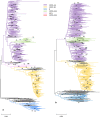Characteristics of HIV-1 molecular transmission networks and drug resistance among men who have sex with men in Tianjin, China (2014-2018)
- PMID: 33143744
- PMCID: PMC7640427
- DOI: 10.1186/s12985-020-01441-8
Characteristics of HIV-1 molecular transmission networks and drug resistance among men who have sex with men in Tianjin, China (2014-2018)
Abstract
Background: In Tianjin, China, there is a relatively high prevalence of HIV in men who have sex with men (MSM). The number of HIV cases in Tianjin is also increasing. We investigated the HIV molecular transmission network, genetic tropisms, and drug resistance mutations in Tianjin.
Methods: Blood samples were collected from 510 newly diagnosed antiretroviral therapy (ART)-naïve HIV-1-infected subjects among MSM in Tianjin. Partial pol and env genes were sequenced and used for phylogenetic, genetic tropism, and genotypic drug resistance analyses. Molecular clusters were identified with 1.5% genetic distance and 90% bootstrap support.
Results: Among the 436 HIV-1 pol sequences obtained from the study participants, various genotypes were identified, including CRF01_AE (56.9%), CRF07_BC (27.8%), B (7.3%), CRF55_01B (4.1%), unique recombinant forms (URFs) (3.7%), and CRF59_01B (0.2%). A higher prevalence of X4 viruses was observed in individuals infected with CRF55_01B (56.3%) and CRF01_AE (46.2%) than with other subtypes. Of all 110 sequences in the 36 clusters, 62 (56.4%) were observed in 23 CRF01_AE clusters and 18 (16.4%) in four CRF07_BC clusters. Eight sequences clustered with at least one other shared the same drug resistance mutation (DRM). In different cluster sizes, the distributions of individuals by age, presence of sexually transmitted disease, and presence of DRMs, were significantly different.
Conclusion: We revealed the characteristics of HIV molecular transmission, tropism, and DRMs of ART-naïve HIV-infected individuals among the MSM population in Tianjin. Identifying infected persons at risk of transmission is necessary for proposing counseling and treating these patients to reduce the risk of HIV transmission.
Keywords: Drug resistance; HIV-1; Men who have sex with men; Tianjin; Transmission network.
Conflict of interest statement
The authors declare that they have no competing interests.
Figures



Similar articles
-
HIV-1 genetic transmission networks among men who have sex with men in Kunming, China.PLoS One. 2018 Apr 26;13(4):e0196548. doi: 10.1371/journal.pone.0196548. eCollection 2018. PLoS One. 2018. PMID: 29698467 Free PMC article.
-
[Transmitted drug resistance among HIV infected men who have sex with men in Tianjin, 2014-2017].Zhonghua Liu Xing Bing Xue Za Zhi. 2018 May 10;39(5):619-624. doi: 10.3760/cma.j.issn.0254-6450.2018.05.015. Zhonghua Liu Xing Bing Xue Za Zhi. 2018. PMID: 29860805 Chinese.
-
Analysis of genotype resistance and HIV-1 transmission risk in HIV-1-infected men who have sex with men in Guiyang, China.Immun Inflamm Dis. 2024 Nov;12(11):e70029. doi: 10.1002/iid3.70029. Immun Inflamm Dis. 2024. PMID: 39552198 Free PMC article.
-
Increase of RT-related transmitted drug resistance in non-CRF01_AE among HIV type 1-infected men who have sex with men in the 7 cities of China.J Acquir Immune Defic Syndr. 2015 Mar 1;68(3):250-5. doi: 10.1097/QAI.0000000000000467. J Acquir Immune Defic Syndr. 2015. PMID: 25469530
-
Understanding disclosed and cryptic HIV transmission risk via genetic analysis: what are we missing and when does it matter?Curr Opin HIV AIDS. 2019 May;14(3):205-212. doi: 10.1097/COH.0000000000000537. Curr Opin HIV AIDS. 2019. PMID: 30946142 Review.
Cited by
-
The characteristics of HIV-1 subtype B on phylogenetic dynamic and molecular transmission network in Fuyang City, China, 2011 to 2019.Front Public Health. 2023 Mar 1;11:1092376. doi: 10.3389/fpubh.2023.1092376. eCollection 2023. Front Public Health. 2023. PMID: 36935727 Free PMC article.
-
HIV incidence and recreational drug use among men who have sex with men aged 18-24 years in Tianjin, China: a retrospective cohort study.BMC Infect Dis. 2024 Nov 14;24(1):1295. doi: 10.1186/s12879-024-10184-8. BMC Infect Dis. 2024. PMID: 39543467 Free PMC article.
-
Drug resistance and genetic transmission characteristics of HIV-1 CRF55_01B in people living with HIV/AIDS (PLWHA) in Henan Province, China.Retrovirology. 2025 May 29;22(1):9. doi: 10.1186/s12977-025-00665-2. Retrovirology. 2025. PMID: 40442753 Free PMC article.
-
Distinct Rates and Transmission Patterns of Major HIV-1 Subtypes among Men who Have Sex with Men in Guangxi, China.Front Microbiol. 2024 Jan 12;14:1339240. doi: 10.3389/fmicb.2023.1339240. eCollection 2023. Front Microbiol. 2024. PMID: 38282731 Free PMC article.
-
The Molecular Epidemiological and Immunological Characteristics of HIV-1 CRF01_AE/B Recombinants in Nanjing, China.Front Microbiol. 2022 Jul 15;13:936502. doi: 10.3389/fmicb.2022.936502. eCollection 2022. Front Microbiol. 2022. PMID: 35910646 Free PMC article.
References
-
- National Center for AIDS/STD Control and Prevention, China CDC Update on AIDS/STD epidemic in China in December 2017. Chin J AIDS STD. 2018;23(2):111.
Publication types
MeSH terms
Substances
LinkOut - more resources
Full Text Sources
Medical

